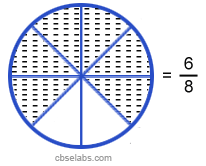Contents
- 1 Adding Fractions When the Denominators are the Same Example 1:
- 2 Adding Fractions When the Denominators are the Same Example 2:
- 3 Adding Fractions When the Denominators are the Same Example 3:
- 4 Adding Fractions When the Denominators are the Same Example 4:
- 5 Adding Fractions When the Denominators are the Same Example 5:
In order to add two or more like fractions, we may follow the following steps:
Step 1) Obtain the fractions.
Step 2) Add the numerators of all fractions.
Step 3) Retain the common denominator of all fractions.
Step 4) Write fraction as \(\frac{Result in Step (2)}{Result in Step (3)}\)
Adding Fractions When the Denominators are the Same Example 1:
Add the following fractions with the help of a diagram.
Solution: Given fractions are \(\frac{2}{8}, \frac{3}{8} and \frac{1}{8} respectively. Their addition is given by:\)
Adding Fractions When the Denominators are the Same Example 2:
Add the following fractions: 1) \(\frac{1}{6} + \frac{4}{6}\)
2) \(\frac{2}{7} + \frac{3}{7} + \frac{4}{7}\)
Solution: 1) We have,
\(\frac{1}{6} + \frac{4}{6}\) = \(\frac{1 + 4}{6}\) = \(\frac{5}{6}\)
2) We have,
\(\frac{2}{7} + \frac{3}{7} + \frac{4}{7}\) = \(\frac{2 + 3 + 4}{7}\) = \(\frac{9}{7}\)
Adding Fractions When the Denominators are the Same Example 3:
Add the following fractions: 1) \(2\frac{3}{5}\) + \(\frac{4}{5}\) + \(1\frac{2}{5}\)
2) \(1\frac{1}{4}\) + \(2\frac{3}{4}\) + \(7\frac{1}{4}\)
Solution: 1) We have,
\(2\frac{3}{5}\) + \(\frac{4}{5}\) + \(1\frac{2}{5}\) = \(\frac{10 +3}{5}\) + \(\frac{4}{5}\) + \(\frac{5 +2}{5}\)
= \(\frac{13}{5}\) + \(\frac{4}{5}\) + \(\frac{7}{5}\)
= \(\frac{13 + 4 + 7}{5}\) = \(\frac{24}{5}\)
2) We have,
\(1\frac{1}{4}\) + \(2\frac{3}{4}\) + \(7\frac{1}{4}\) = \(\frac{4 + 1}{4}\) + \(\frac{8 + 3}{4}\) + \(\frac{28 + 1}{4}\)
= \(\frac{5}{4}\) + \(\frac{11}{4}\) + \(\frac{29}{4}\)
= \(\frac{5 + 11 + 29}{4}\) = \(\frac{45}{4}\)
Adding Fractions When the Denominators are the Same Example 4:
Add \(\frac{2}{13}\) and \(\frac{7}{13}\).
Solution: \(\frac{2}{13}\) and \(\frac{7}{13}\) are like fractions.
In order to add them, just add the numerators without changing the denominator.
i.e., \(\frac{2}{13} + \frac{7}{13}\) = \(\frac{2 + 7}{13}\)
= \(\frac{9}{13}\)
Thus, \(\frac{2}{13} + \frac{7}{13}\) = \(\frac{9}{13}\).
Adding Fractions When the Denominators are the Same Example 5:
Add \(\frac{1}{12}\), \(\frac{3}{12}\) and \(\frac{5}{12}\).
Solution: \(\frac{1}{12}\), \(\frac{3}{12}\) and \(\frac{5}{12}\) are like fractions.
In order to add them, just add the numerators without changing the denominator.
i.e., \(\frac{1}{12} + \frac{3}{12} + \frac{5}{12}\) = \(\frac{1 + 3 + 5}{12}\)
= \(\frac{9}{12}\)
Thus, \(\frac{1}{12} + \frac{3}{12} + \frac{5}{12}\) = \(\frac{9}{12}\).

